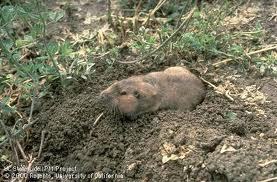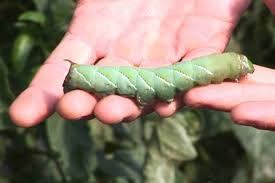The allure of stalking game wasn't something I understood until I spent a perfect day planting seedlings only to discover the next morning that said seedlings had disappeared. In cartoons, you have probably seen red-faced people with steam coming out of their ears. That was me.
I am now on a mission. I hunt the information highway for ammunition and stalk game in my yard. I now understand the thrill of the hunt. Learning how to vanquish a certain pest and implementing the technique in my garden makes my day.
Early on I decided that I was going to avoid chemical warfare. So I comb the library and the Internet and question acquaintances and sometimes complete strangers for information and success stories. Here is my hit list:
Earwigs are one common problem in my garden. I was surprised to learn that they are considered somewhat beneficial as they eat soft-bodied insects and their eggs. I chose to control them because they damage seedlings and soft fruit.
Earwigs like moist, dense undergrowth and debris, so control them by installing a drip system and cleaning up detritus. Check plant support stakes. If they are hollow, replace them. Earwigs hide inside hollow stakes during the day.
Trap earwigs with rolled-up newspaper, short pieces of hose or toilet paper rolls. Place your choice of traps near the affected area at dusk. In the morning, collect traps and shake them out over a bowl of soapy water.
Another tactic is to bury a tuna or cat-food tin up to the rim. Add 2 tablespoons vegetable oil and a small amount of bacon grease or fish oil as an attractant. Check daily and dump out any dead insects; refill with oil and replace the trap. After a week of diligence, you should notice a marked decrease in population. Then just stay on top of it. If it looks like earwigs are returning, repeat the process.
Hornworms are a huge pest, literally. One of my friends said that the first time she saw one, she screamed so loud that her husband came running. The best way to deal with these meaty monsters is to don garden gloves and either hand-pick them or, as my friend does, use kitchen tongs. If you have chickens or other fowl, you will make their day by flinging this rotund pest into their area.
There are not many plants that aphids don't like. However, they rarely kill plants, and you can usually wash them off with water or squish them. Interestingly, they tend to avoid plants that have their squashed brethren on them.
To control aphids, I make a 10 percent blend of non-detergent liquid dish soap and water and spray it directly on the plant. Wherever you find aphids, you will likely find ants. Get rid of the ants and the aphids have no protection from predators. When aphid populations climb, natural enemies like lady beetles and lacewings descend to feed on them.
According to lore, a Frenchman introduced snails to California during the Gold Rush—a food crop that went horribly wrong. Their overwhelming number today substantiates my belief that messing with Mother Nature has consequences. Snail presence in the garden is unmistakable because of the slimy trails they leave behind. Remove moist environments and clean up debris to control them. In my experience, the best traps are 12”x12” boards randomly laid around the yard. I go outside early in the morning, turn each board over and smash the attached snails. Keep at it for a week and you will prevail; then you just need to monitor for signs of their return.
Beneficial insects play a role, too. My kids and I purchased lady beetles one year and enjoyed the experience. Purchase lady beetles that have been kept under refrigeration and release them at dusk for best results.
The University of California's IPM web site (http://www.ipm.ucdavis.edu/PMG/PESTNOTES/) has extensive information on pest control. I have had great success implementing this research in my garden, and I believe that you, too, will reap the rewards.
Master Gardeners are volunteers who help the University of California reach the gardening public with home gardening information. Napa County Master Gardeners ( http://ucanr.org/ucmgnapa/) are available to answer gardening questions in person or by phone, Monday, Wednesday and Friday, 9 a.m. to Noon, at the U. C. Cooperative Extension office, 1710 Soscol Avenue, Suite 4, Napa, 707-253-4143, or from outside City of Napa toll-free at 877-279-3065. Or e-mail your garden questions by following the guidelines on our web site. Click on Napa, then on Have Garden Questions? Find us on Facebook under UC Master Gardeners of Napa County.

You have probably had experience with some of these pesky animals, such as gophers, moles, voles, ground squirrels and rats. It is the lucky gardener who has never encountered at least one of them.
If you have a gopher problem, check out the gopher pest notes on the University of California at Davis website (http://www.ipm.ucdavis.edu/PMG/PESTNOTES/pn7433.html). There you will find information on how to identify and control moles, voles and other small rodent pests.
For rural dwellers, the list of vertebrate pests grows and includes raccoons, opossums and skunks. These three are nocturnal foragers and happily snatch fruit from your trees, berries from your vines, vegetables from your garden and eggs from your hen house. They have little fear of humans and will often return nightly to enjoy pet food left in bowls on back porches. Lights often do not bother them. Having a family of raccoons on your back porch at night can be entertaining at first, but they quickly make themselves unwelcome.
If you find yourself with a raccoon, skunk or opossum family visiting your home regularly, try to remove temptations and access. Bring in pet food bowls at night, and close pet doors. Skunks and raccoons can easily enter through these small openings, and confronting a skunk in your kitchen in the middle of the night is not what you want on your list of memorable experiences.
Make sure screens over chimneys and flues are substantial and attached. These cozy places, dark and confined, seem like perfect nurseries to raccoons and opossums looking for places to nest and raise their young.
Keep compost and trash receptacles tightly closed. Remove hiding places behind wood piles, and block access underneath decks.Seal off any openings that a small rodent could get through. They may look cute,but these animals often carry diseases, ticks and other pathogens, and they can get into tussles with animals you love.
If you need help getting rid of these pests or bigger wildlife like mountain lions, beavers and mink (yes, we have those),contact Napa County Wildlife Services (http://www.countyofnapa.org/AgCommissioner/Wildlife Services/).
If you live in deer country, you know you cannot grow tulips and many other fruits, vegetables or flowers without a fence or a dog. The only alternative is to grow the few plants that deer won't (usually) eat. That list includes daffodils, lavender, hyacinth, irises, sweet William and sage. Sometimes, instead of managing a pest, we just have to learn to co-exist.
Birds have vertebrae, too, and can definitely be pests. Many of us have competed with birds for a long-awaited crop of cherries or grapes. Or maybe you have waited patiently for your peaches to be perfectly ripe, only to find that a blackbird, raven or other feathered foe has been waiting as patiently for perfection as you have.
Birds are often the culprits behind disappearing seedlings in the garden. After planting pea or bean seeds, I may make several treks to the bed each day to watch the progress. It's an exciting day when the seed forces itself up through the soil with its first leaves spreading out to catch the sun. More than once, I have approached the bed eagerly in the morning, anxious to see the amazing overnight growth, only to find the seedlings completely gone or the leaves nipped off. The list of suspects is long, but the offender is all too often a bird.
The only reptile on the University of California's list of vertebrate pests is the friendly little lizard, but I consider a lizard a pest only if we are competing for the same warm rock.
Workshop: Join Napa County Master Gardeners for a workshop on “Critters in the Garden” on Sunday, September 21, from 2 p.m. to 4 p.m., at the Yountville Community Center, 6516 Washington Street, Yountville. Learn to identify and manage the many critters that invade your garden by air, by land and from underground. Learn techniques for managing gophers, moles, voles, rabbits, squirrels, deer and birds. To register, call the Yountville Parks & Recreation Department at 707-944-8712 or their website.
Workshop: Napa County Master Gardeners will conduct a workshop titled “Be Successful with Citrus” on Saturday, Octobe 11, from 9:30 a.m. to 11:30 a.m. Discover all the tools you need to be successful with your new or mature citrus trees. Learn about choosing varieties, planting and fertilizing trees and protecting them from frost.The workshop will be held at the Senior Multi-Use Center, 2185 Elliott Drive, American Canyon. Online registration (credit card only)Mail in registration (cash or check only)
Master Gardeners are volunteers who help the University of California reach the gardening public with home gardening information. Napa County Master Gardeners ( http://ucanr.org/ucmgnapa/) are available to answer gardening questions in person or by phone, Monday, Wednesday and Friday, 9 a.m. to Noon, at the U. C. Cooperative Extension office, 1710 Soscol Avenue, Suite 4, Napa, 707-253-4143, or from outside City of Napa toll-free at 877-279-3065. Or e-mail your garden questions



